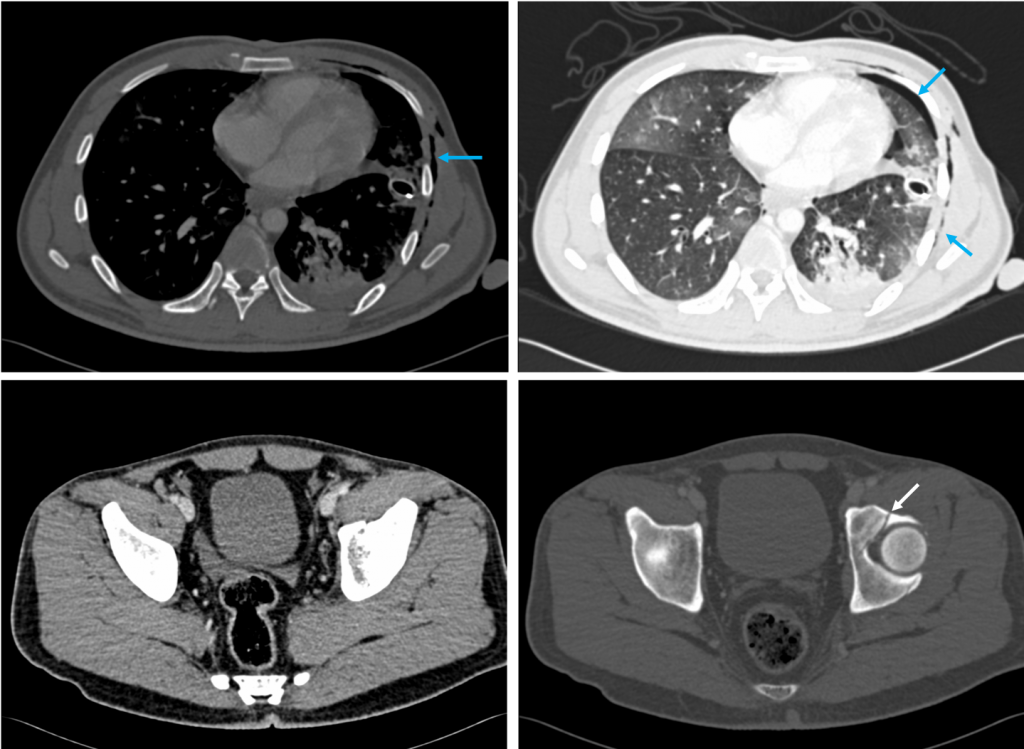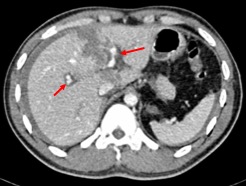Case contribution: Dr Radhiana Hassan
Clinical:
- A 28 years old man
- A lorry driver, burst tyre and lorry skidded into a drain
- Post trauma complaint of chest pain and pain at both LL
- Also had headache but no loss of consciousness
- Vital signs on arrival at ED: GCS=15/15, BP=90/60 mmHg, PR=76 bpm
- CXR shows fracture of left upper ribs with pneumothorax
- Chest tube inserted
- Also had midshaft comminuted fracture of tibia and degloving injury left lower limb


CT scan findings:
- A liver laceration at Segment IV measuring about 4 cm in length (yellow arrows)
- Extension of laceration to porta hepatis region
- Within the liver, periportal tracking is seen (red arrows)
- Moderate hemoperitoneum
- Other organs are normal. No pneumoperitoneum
- View of lower thoracic region shows left pneumothorax with chest tube in-situ, bilateral lung contusion and subcutaneous emphysema (blue arrows)
- Patient also had fracture of left acetabulum (white arrow)
Diagnosis: Polytrauma with liver Grade II liver injury
Discussion: Periportal tracking on CT scan
- Periportal tracking also known as periportal halo or periportal collar sign refers to a low density region seen around the portal veins on contrast-enhanced CT or hypoechogenicity on liver ultrasound.
- It likely represents periportal edema, which is often used as a synonymous term.
- Periportal haloes may occur around the central portal veins or their peripheral branches and occur on both sides of the portal triads.
- It have been described in a variety of disorders.
- In the setting of blunt abdominal trauma, the zones have been attributed to dissection of blood along the portal tracts.
- Both hemorrhage and lymphatic edema may be represented as periportal tracking after blunt abdominal injury.
- In a study, it was reported that extrahepatic injuries beneath the liver were associated in 22 of 28 patients with periportal tracking and in 2 of 17 without periportal tracking
- Hepatic complications such as bile leak, biloma, hemobilia, and infected hematoma w with periportal tracking was significantly higher
- Periportal tracking on CT implies injury to the subhepatic region and intrahepatic portal triads and that it requires careful examination for extrahepatic injuries in the initial management and late hepatic complications in the follow-up management.
- Other causes of periportal tracking in non-trauma patients include congestive cardiac failure, acute hepatitis, lymphatic obstruction at porta hepatis, liver transplant, liver transplant, bone marrow transplant, cholangitis and acute pyelonephritis.
Progress of patient:
- Conservative management for intra abdominal injury.
- Wound debridement and external fixation of distal third tibia fracture
- Patient was discharge after 3 weeks hospitalization
- Patient recovered well

Recent Comments